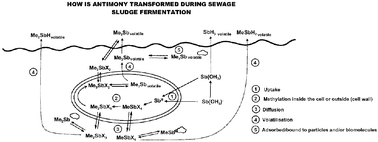Antimony is distributed in the environment in inorganic and organic species with different solubility and mobility characters. Here we investigate the transformation of antimony in view of biomethylation during sewage sludge fermentation as a case study for an anaerobic environment. Our approach was to identify if antimony methylation follows the Challenger pathway by using isotopically enriched antimonite (123Sb(V)). The antimony source was subjected to methylation in sewage sludge, an anaerobic dominant methanogenic Archaea community. The antimony species were determined in the gas phase using cryotrapping (CT)-GC-ICP-MS, and in the medium (sewage slude) by hydride generation (HG) prior CT-GC-ICP-MS. The determined 123/121Sb isotope ratios in the volatile trimethylstibine and non-volatile methylantimony species indicated that the methylation follows the proposed methylation pathway. With this approach we were able to quantify 123Sb incorporation into monomethyl-, dimethyl- and trimethylantimony, respectively. The incorporation decreased with further methylation from 91% to 82% and 73%. Volatilisation as trimethystibine was generally lower than 0.1%, however, up to 0.8% of added antimony was found methylated to methylantimony species and mainly accumulated in the cell. Moreover, antimony biomethylation was enhanced by stimulation of the anaerobic communities of methanogenic Archaea and sulfate reducing bacteria (SRB), with the methanogens showing a higher activity.

You have access to this article
 Please wait while we load your content...
Something went wrong. Try again?
Please wait while we load your content...
Something went wrong. Try again?


 Please wait while we load your content...
Please wait while we load your content...